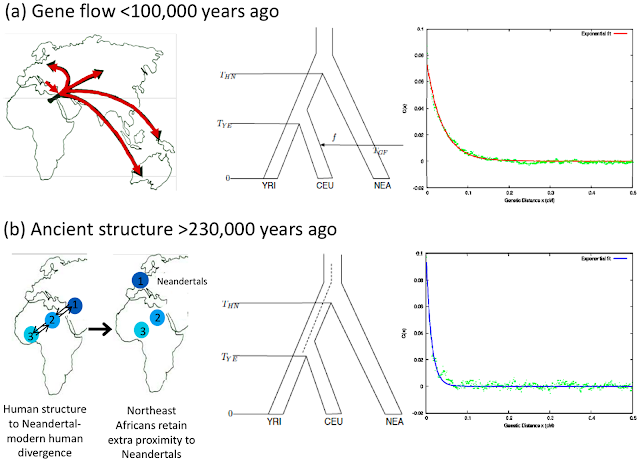Dating the last common ancestor of modern humans and neanderthals
To
discover why Neandertals are most closely related to people outside
Africa, Harvard and Max Planck Institute scientists have estimated the
date when Neandertals and modern Europeans last shared ancestors. The
research, published in the journal PLoS Genetics,
provides a historical context for the interbreeding. It suggests that
it occurred when modern humans carrying Upper Paleolithic technologies
encountered Neandertals as they expanded out of Africa.
When the Neandertal genome was sequenced in 2010 it revealed that people outside Africa share slightly more genetic variants with Neandertals than Africans do. One scenario that could explain this observation is that modern humans mixed with Neandertals when they came out of Africa. An alternative, but more complex, scenario is that African populations ancestral to both Neandertals and modern humans remained subdivided over a few hundred thousand years and that those more related to Neandertals subsequently left Africa.
Dr. Sriram Sankararaman and colleagues measured the length of DNA pieces in the genomes of Europeans that are similar to Neandertals. Since recombination between chromosomes when egg and sperm cells are formed reduces the size of such pieces in each generation, the Neandertal-related pieces will be smaller the longer they have spent in the genomes of present-day people.
The team estimate that Neandertals and modern humans last exchanged genes between 37,000 and 86,000 years ago, well after modern humans appeared outside Africa but potentially before they started spreading across Eurasia. This suggests that Neandertals (or their close relatives) had children with the direct ancestors of present-day people outside Africa.
Source: Public Library of Science [October 04, 2012]
When the Neandertal genome was sequenced in 2010 it revealed that people outside Africa share slightly more genetic variants with Neandertals than Africans do. One scenario that could explain this observation is that modern humans mixed with Neandertals when they came out of Africa. An alternative, but more complex, scenario is that African populations ancestral to both Neandertals and modern humans remained subdivided over a few hundred thousand years and that those more related to Neandertals subsequently left Africa.
Dr. Sriram Sankararaman and colleagues measured the length of DNA pieces in the genomes of Europeans that are similar to Neandertals. Since recombination between chromosomes when egg and sperm cells are formed reduces the size of such pieces in each generation, the Neandertal-related pieces will be smaller the longer they have spent in the genomes of present-day people.
The team estimate that Neandertals and modern humans last exchanged genes between 37,000 and 86,000 years ago, well after modern humans appeared outside Africa but potentially before they started spreading across Eurasia. This suggests that Neandertals (or their close relatives) had children with the direct ancestors of present-day people outside Africa.
Source: Public Library of Science [October 04, 2012]
